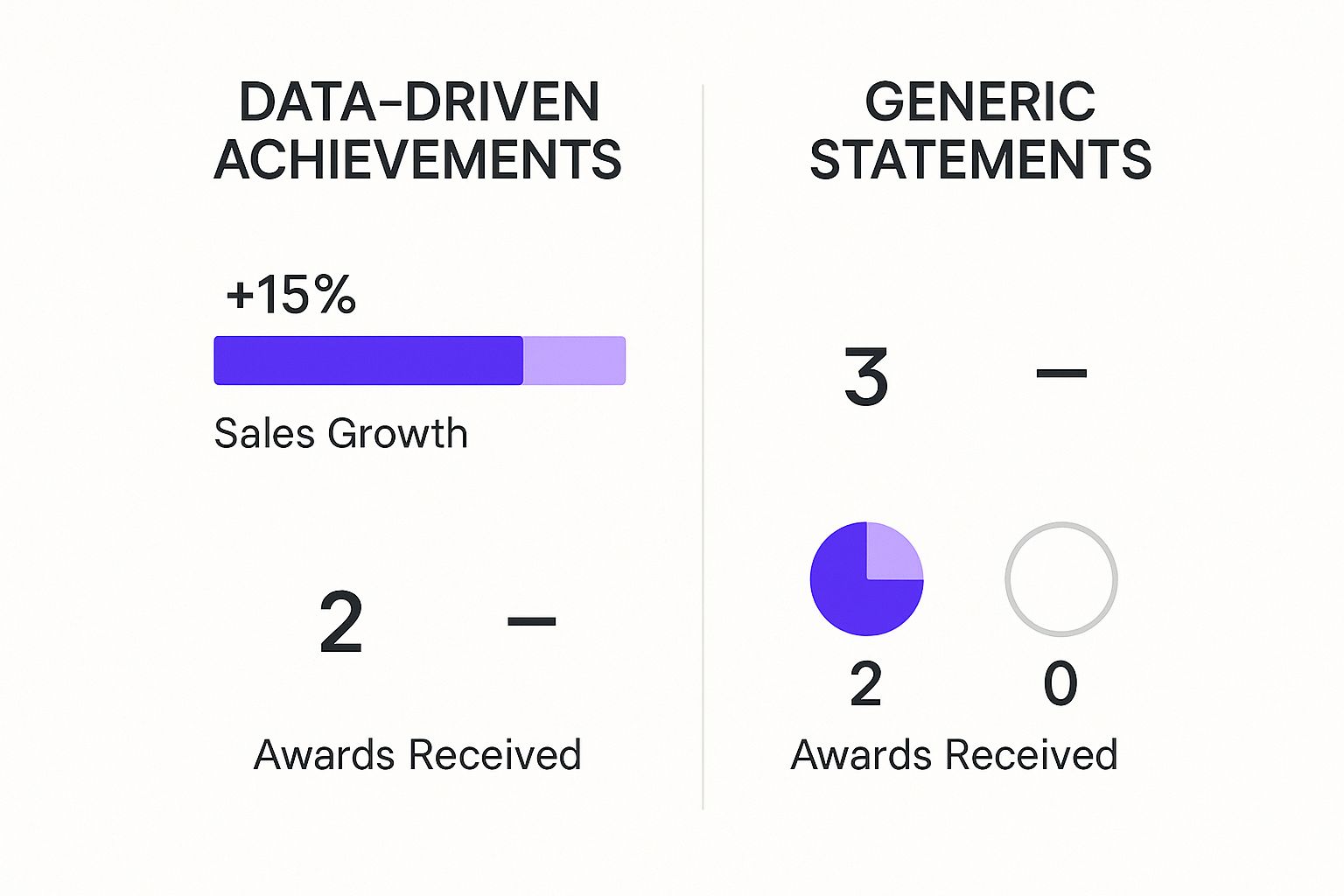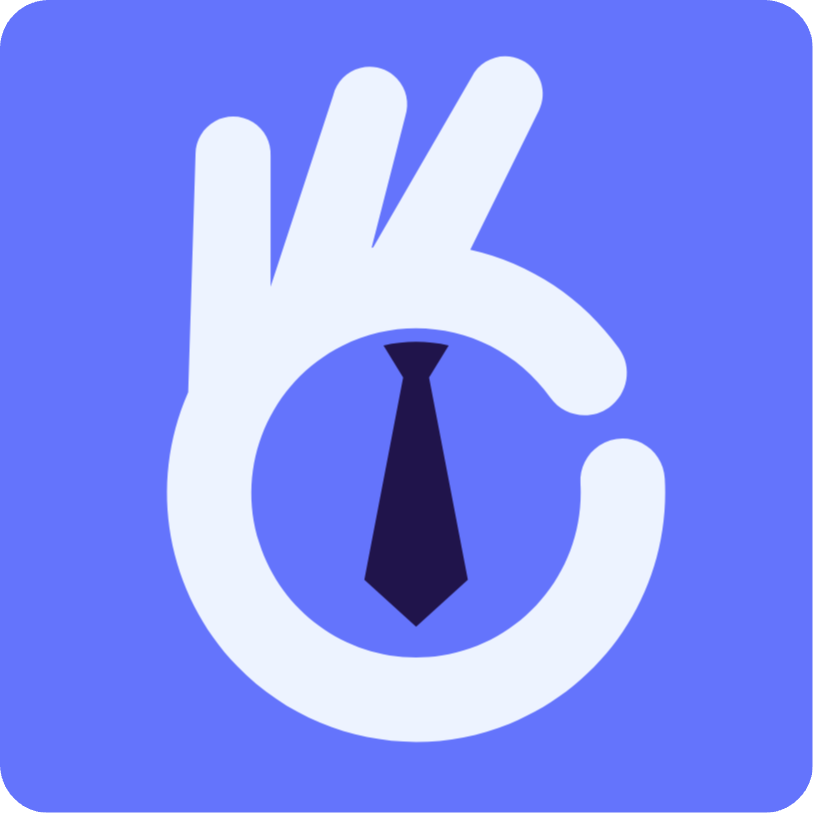How to Make My Resume Better for More Interviews
Before a human ever lays eyes on your resume, it has to get past the digital gatekeeper. It’s a hard truth, but over 98% of Fortune 500 companies use an Applicant Tracking System (ATS) to do the initial screening. They get hundreds, sometimes thousands, of applications for one role, and this software is their first line of defense.
The thing is, this software isn't impressed by your fancy fonts or creative layouts. It's a data-parsing bot. If it can’t read your resume, you're out. Simple as that. Your incredible experience means nothing if it gets tossed into the digital void.
So, how do you beat the bots?
Crafting a Resume That Gets Seen
Your first job isn't to impress a hiring manager—it's to create a resume that a machine can easily understand. This means thinking clean, simple, and predictable.
Stick to Standard Formatting
An ATS is programmed to look for specific information in expected places. If you get too creative with your section titles, the software gets confused and might skip over entire chunks of your career history.
Always, and I mean always, use standard headings.
- Work Experience (or Professional Experience)
- Education
- Skills
- Certifications
Ditch the artsy titles like "My Professional Journey" or "Where I've Studied." They might sound clever to you, but an ATS will likely ignore them completely, leaving the human reviewer with a half-empty profile of your qualifications.
This same logic applies to the file format. While a PDF keeps your design looking sharp, some older ATS platforms still have trouble reading them. A .docx file is often the safest bet because it’s universally parsable. Of course, always follow the specific instructions in the job application—if they ask for a PDF, give them a PDF.
Pro Tip: Stay far away from tables, columns, text boxes, or images on your resume. These are notorious for tripping up an ATS. A clean, single-column layout is the gold standard for a reason—it works.
Weave in Keywords Strategically
Once your structure is solid, it's time to focus on the language. The ATS is scanning for keywords and skills pulled directly from the job description to see if you’re a match. Your goal is to mirror that language, but in a way that feels natural.
Look at the job posting. If it calls for experience with "project management software," you need to have that exact phrase in your resume. If it lists "data analysis" and "stakeholder communication" as must-haves, work those terms into the bullet points describing your accomplishments.
Not sure if you’ve hit the mark? A great way to check is with a specialized tool. You can get an instant analysis with a dedicated resume ATS checker to see exactly how your document stacks up against a specific role.
Job hunting abroad? Keep in mind that cultural norms change, and you might need to explore different strategies for writing a compelling CV to fit local expectations. But no matter where you're applying, the fundamental rule is the same: beat the bots first.
Tailoring Your Skills for the Modern Job Market

A generic, one-size-fits-all resume is the fastest way to get your application tossed in the "no" pile. Think about it—you wouldn't send the same text to your boss that you’d send to your best friend, right? The context is completely different. Your resume works the same way; it needs to be uniquely customized for every single job you apply for.
The real secret to a standout resume is meticulous tailoring. Before you even start writing, you need to put on your detective hat. Scour the job description for clues. What specific skills, technologies, and qualifications pop up over and over again? Those are your high-priority keywords, and they're your ticket past the initial screening.
Hard Skills vs. Soft Skills
Every job demands a mix of two kinds of abilities: hard skills and soft skills. Knowing the difference is a game-changer for how you structure your resume.
- Hard Skills are your teachable, technical abilities. Things like programming languages, specific software proficiency, or data analysis fall into this bucket. They are concrete and measurable.
- Soft Skills are the interpersonal traits that define how you work. This is your communication style, leadership ability, teamwork, and problem-solving.
While a dedicated "Skills" section is perfect for listing hard skills, your soft skills shine brightest in your "Work Experience" section. Don't just claim you have "strong leadership." Instead, describe a time you led a team to smash a deadline and finish a project ahead of schedule.
Your hard skills get you past the ATS; your soft skills, proven through experience, get you the interview. Show, don't just tell.
Reading the Market and Customizing Your Skill Set
The job market is always changing, and the skills that are in demand shift right along with it. If you keep a pulse on these trends, you'll have a serious edge. Recent analysis shows some dramatic shifts in what helps a candidate get noticed.
For software and IT roles, there's been an explosion in resumes mentioning cloud skills. Mentions of DynamoDB, for example, appeared 157.63% more often in Q1 2025. Other tech skills like CSS3 and FastAPI also basically doubled in frequency. This isn't just for developers, either. In Product Management, even technical skills like Python saw a 48.61% growth in mentions. You can dig into more of these fascinating job search trends from Q1 2025 on Huntr.co.
The data tells a clear story: you absolutely have to align your skills with what the market wants right now.
Let's walk through a real-world example.
Scenario: The Software Developer
Imagine a developer applying for two different jobs. One is a backend role that needs Python and FastAPI. The other is a full-stack position asking for React and AWS.
- For the backend role, they should feature Python, FastAPI, and database management skills right at the top of their skills list and weave them into their project descriptions.
- For the full-stack role, they need to shuffle things around. Now, React, JavaScript, and AWS should be front and center, with their backend experience still present but taking a supporting role.
That simple adjustment makes sure the most relevant skills are seen first, instantly telling the hiring manager, "I'm a great fit." This kind of customization is a core strategy for making your resume not just good, but incredibly effective for each application.
Turning Job Duties Into Powerful Achievements

Let's be honest, the experience section is the most valuable piece of real estate on your resume. But far too many people just copy and paste their job duties straight from a formal job description. That’s a massive missed opportunity.
Recruiters don’t just want to know what you were supposed to do. They want to know what you actually did—and what difference it made.
Think of it like this: a job description lists responsibilities, but a stellar resume showcases results. This shift in mindset is what separates a good resume from a great one. You need to stop listing passive duties and start framing them as active achievements.
A fantastic way to do this is with the STAR method. It's typically taught for interviews, but it works brilliantly for crafting compelling resume bullet points. STAR stands for:
- Situation: What was the context? Briefly set the scene.
- Task: What was your goal or the problem you needed to solve?
- Action: What specific steps did you take? Use strong, active verbs here.
- Result: This is the most important part. What was the outcome? Use numbers to prove it.
This framework forces you to focus on the results, which is exactly what catches a hiring manager's eye.
From Bland to Brilliant with Examples
Let’s look at how to transform a few common, uninspired duties into achievement-focused bullet points that actually grab attention.
Before:
- Managed social media accounts.
After:
- Grew social media engagement by 45% in six months by implementing a new data-driven content strategy focusing on video and user-generated content.
See the difference? The "After" version gives them a hard number (45%), a clear timeframe (six months), and explains how you did it. It tells a complete and impressive story.
Here's another one.
Before:
- Responsible for customer support.
After:
- Reduced customer ticket resolution time by 30% by creating a new internal knowledge base and training the support team on its use.
A resume packed with quantifiable achievements proves your value before you even get on the phone with a recruiter. It signals that you're a results-oriented professional who understands how your work contributes to the bigger picture.
I know that crafting these achievement-driven points can feel tough. Sometimes you're just too close to the work to see it clearly. That’s where modern tools can give you a major assist. The AI-powered features inside a good resume builder can suggest ways to rephrase your duties into impactful statements, making sure you present your absolute best self.
It’s all about turning your past work into compelling proof of your future potential.
When you're light on professional experience, you have to play a different game. What you can do often speaks louder to a hiring manager than where you went to school or what your last job title was. If your work history feels a bit thin or your degree isn't a perfect match, it's time to shift the focus.
This means flipping the traditional resume structure on its head. Instead of leading with your education, try putting a strong "Skills" or "Projects" section right at the top, just under your professional summary. This move immediately grabs a recruiter's attention and shows them you have the practical, hands-on abilities they need—no matter what your formal experience looks like.
Showcase Your Practical Abilities
Your skills section needs to be more than just a laundry list of buzzwords. Group your abilities into logical categories like "Programming Languages," "Marketing Tools," or "Project Management." But don't just list them. For every skill you claim, be ready to prove it with a real example.
This is where a dedicated "Projects" section becomes your secret weapon. It’s your chance to shine a spotlight on relevant work from freelance gigs, personal passion projects, or even complex academic assignments you knocked out of the park.
- Freelance Project: Built a responsive e-commerce website for a local boutique using Shopify, which directly led to a 20% increase in their online sales.
- Personal Project: Developed a mobile app to track personal fitness goals. It gained over 500 downloads in the first month just from organic social media promotion.
See the difference? These concrete examples are proof. They turn a simple claim into a credible, impressive achievement.
Hiring managers are tired of fluff. They're looking for demonstrated capability. A well-documented project that walks them through your process and shows real results can easily outshine an entry-level job title from five years ago.
This infographic really nails the difference between a generic statement and a powerful, data-driven achievement.

It’s pretty clear how adding specific numbers and outcomes transforms a vague responsibility into a compelling accomplishment that makes a recruiter stop and pay attention.
Align with Modern Hiring Priorities
This skills-first approach isn't just a clever trick; it's about aligning your resume with how companies actually hire today. The trend is shifting away from a strict obsession with formal degrees and toward a much greater appreciation for proven abilities. By 2025, an estimated 65% of employers will prioritize practical skills over academic degrees.
A recent study from ResumeGenius.com on HR statistics shows that 81% of hiring managers now view AI-related skills as a critical factor, while 54% continue to emphasize the importance of soft skills. This data gives you a clear roadmap.
This table breaks down the shift in thinking:
Resume Focus: Traditional vs. Modern
| Resume Element | Traditional Approach (Less Effective) | Modern Approach (More Effective) |
|---|---|---|
| Top Section | Education and Work History listed first | Professional Summary followed by a prominent Skills/Projects section |
| Experience | Lists job duties and responsibilities | Highlights quantifiable achievements and results (e.g., "Increased sales by 15%") |
| Skills | A simple, unorganized list of keywords | Categorized skills with proficiency levels and links to project examples |
| Education | Placed at the top, regardless of relevance | Placed lower, unless it's a specific requirement for the role |
| Focus | Chronological history of employment | Demonstrated capabilities and relevance to the target job |
The takeaway is simple: the modern, skills-first resume is designed to answer the recruiter's most important question: "Can this person do the job?"
By strategically featuring your relevant technical skills, personal projects, and certifications right up front, you're telling a powerful story. You're showing that you're not just capable, but also proactive and perfectly in tune with what the modern workplace actually needs. That makes you a much more compelling candidate.
Building Your Brand Beyond the Document

A strong resume tells a story, but these days, it’s only chapter one. In today’s hiring world, recruiters don’t just stop at your PDF. They’re looking for a consistent narrative across your entire digital footprint, which means your personal brand is just as critical as your bullet points.
The goal here is to build a seamless, professional identity that backs up every skill and achievement you've so carefully documented on your resume.
The first place to start? Your LinkedIn profile. It's the most critical step. Think of LinkedIn as the dynamic, living version of your resume. A mismatch between the two can cause confusion or, even worse, raise red flags about your attention to detail.
Synchronize Your Professional Profiles
Your LinkedIn profile is way more than just an online C.V.; it's a powerhouse for networking and branding.
- Your Headline: Don't just list your current job title. Pack it with keywords that show your expertise and where you want to go next. Think something like, "Senior Software Engineer | Python, AWS, and Cloud Architecture."
- Your Summary: This is your chance to tell your career story. It should echo the key achievements from your resume's summary but with a bit more personality and flair.
- Your Experience: Go deeper than your resume's bullet points. On LinkedIn, you have the space to link out to projects, add videos or presentations, and gather recommendations that prove you know your stuff. This is where strategic job search networking really comes into play, turning a static profile into an active career tool.
Building a cohesive online brand is a non-negotiable extension of a great resume. It solidifies your digital identity. If you're looking to really nail this, it's worth learning how to build your personal branding online.
The Untapped Power of Social Links and Video
By 2025, an estimated 67% of employers will be using social media to screen candidates. Yet, the shocking part is that less than 1% of resumes actually include links to profiles like Instagram or Twitter. That’s a huge, missed opportunity to show more of your personality and professional passions.
A well-chosen social media link can be a game-changer. For a graphic designer, a link to a polished Instagram or Behance profile is a must. For a writer, linking to a blog or Medium profile provides instant proof of their skills.
Another trend that’s gaining serious traction is the video resume. While it's not a fit for every industry, a video can be incredibly powerful for roles that demand strong communication skills, like sales or marketing.
In fact, data shows that 79% of hiring managers find video to be a useful tool in the vetting process. A quick, 60-second video introducing yourself and your key strengths can give you an edge that a static document never could. It lets you put your enthusiasm and communication style on full display, making a truly memorable impression.
Answering Those Nagging Resume Questions
Even when you feel like your resume is 99% there, a few small questions can hold you back from hitting "send." Let's clear up some of the most common sticking points I see so you can finalize your resume with complete confidence.
How Long Should My Resume Be?
If you have under 10 years of experience, stick to the one-page rule. Think of it less as a rule and more as a challenge. It forces you to be ruthless and cut anything that doesn't scream "I am perfect for this job." Every single line has to earn its place.
Now, if you're a senior-level pro with a long and very relevant career history, a two-page resume is perfectly fine. The key word here is relevance. Don't add filler just to hit that second page—recruiters can spot it a mile away. Brevity shows you're confident in your top accomplishments.
Should I Use a Creative Design or Add a Photo?
Let's make this simple. For jobs in the United States, the UK, or Canada, do not add a photo. It’s a standard professional norm to help companies avoid unconscious bias, and including one can make you look out of touch.
When it comes to creative designs, your industry is your guide. A graphic designer's resume absolutely should show off their design chops. But for most corporate roles in finance, law, or engineering, a clean, classic, and professional format wins every time. Plus, a super-stylized resume can confuse an Applicant Tracking System (ATS), getting your application tossed before a human ever sees it.
Your goal is to blow them away with your achievements, not your font choices (unless you're a designer). When in doubt, always choose clarity and readability.
How Do I Handle an Employment Gap?
The trick to handling an employment gap is to frame it strategically, not defensively. You don't need a line item that says, "Took a year off." Instead, show them what you were doing.
Here are a few ways to do it:
- Add a "Professional Development" section to highlight any courses, certifications, or workshops you took.
- Create a "Projects" section to showcase freelance work, significant volunteer roles, or personal projects you tackled.
- Use years instead of months for job dates (e.g., 2022–2023). This can smooth over a shorter gap without being misleading.
This approach turns a potential red flag into a story of proactive growth. Of course, you should be ready to talk about it in an interview. For more on that, check out our tips for job interview practice to handle those tricky questions like a pro.
Ready to stop stressing and start getting interviews? Let Eztrackr’s AI tools help you build a powerful, ATS-friendly resume, track all your applications in one place, and land your next role faster. Try Eztrackr today.
 Interview Sidekick
Interview Sidekick